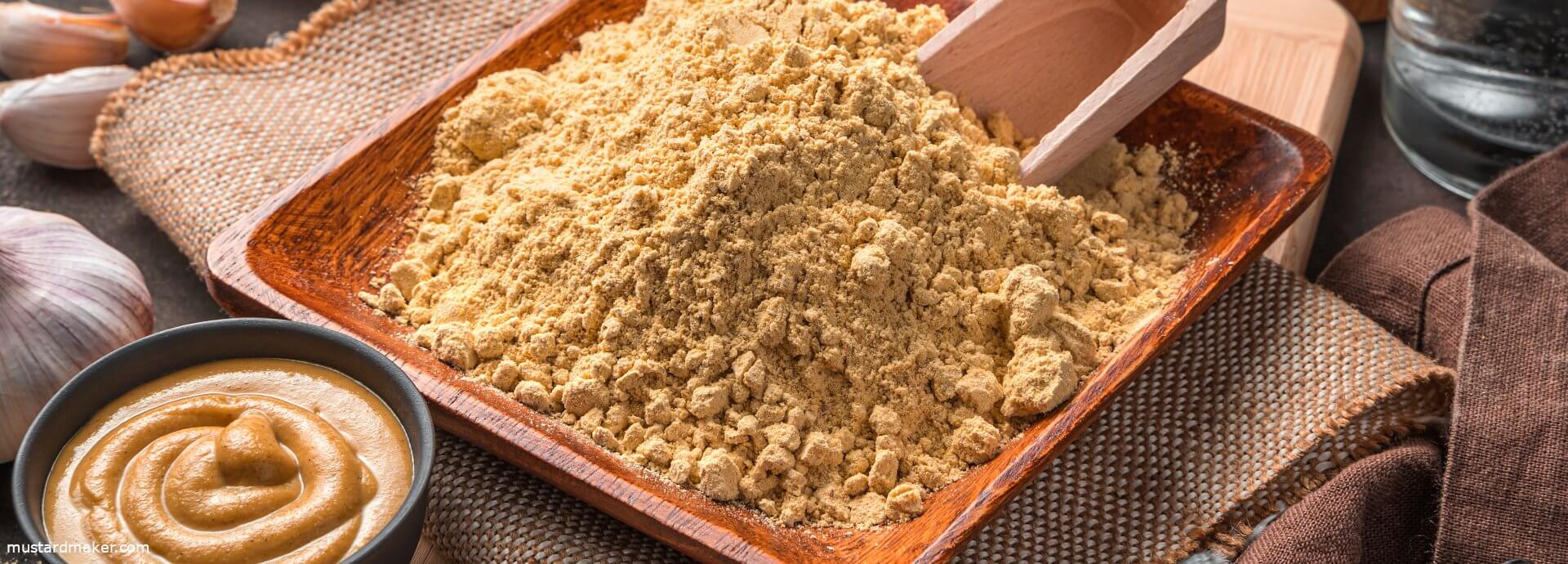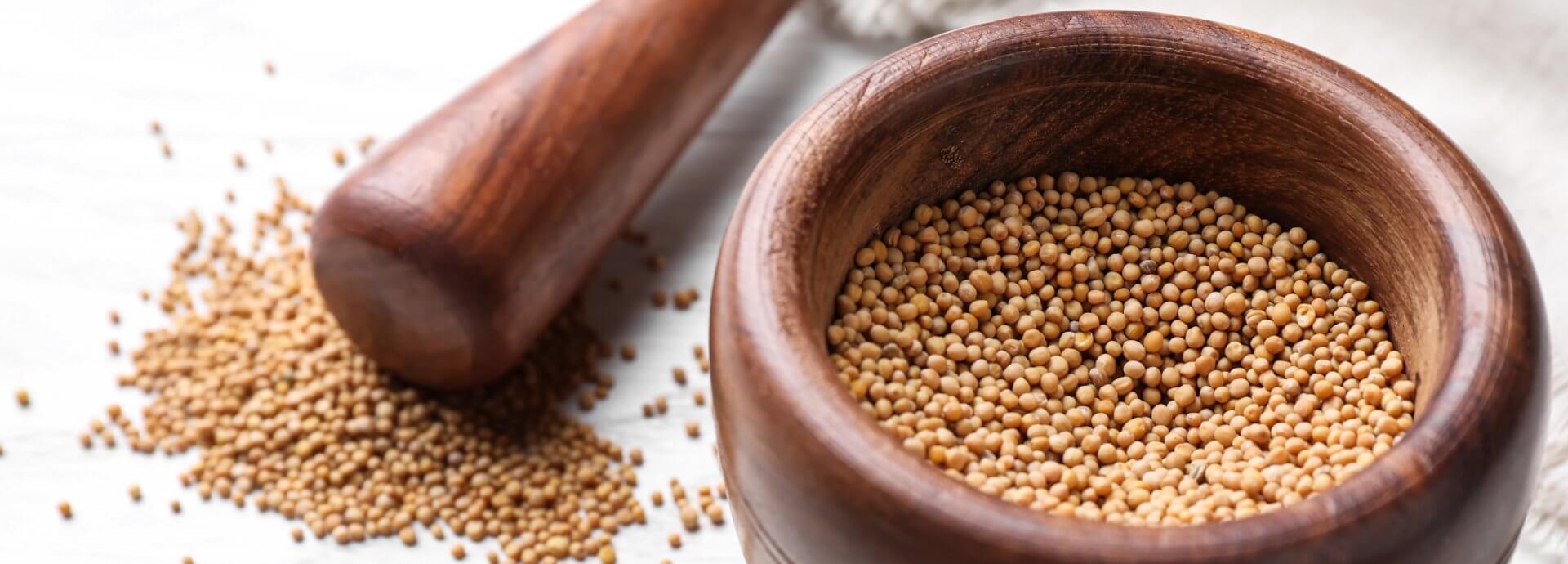Processing mustard into mustard paste
Mustard seeds or mustard seeds ground into mustard flour are the basic requirement for the production of mustard. If you already use mustard powder, then you save the grinding or crushing of the mustard seeds with a mortar or an electric mill. Grinding or crushing is an essential step because it breaks down the cell membranes of the individual mustard seeds and the myrosynase mixes with the glycosides. Only when liquid (vinegar, mustard, water, lemon) and salt are then added to the mustard flour, is mustard paste produced with the characteristic pungency due to allysenf oil and sinalbinsenf oil. For fermentation you should allow at least two hours.

Table of Contents
Mustard flour: the correct use
Mustard flour is used for mustard production, seasoning and as a natural remedy.
What is mustard flour?
Mustard flour is ground mustard seeds. Depending on the manufacturer, grain flour, spices and also curry powder are added. The color of mustard flour differs by mustard flour into white mustard, brown mustard or black mustard in color and pungency. Depending on your preference, manufacturers mix hot and not so hot mustard seeds to make hot or not so hot mustard flour. However, the pungency only comes out when the mustard flour is stirred into liquid.
Mustard flour as a condiment
Mustard powder refines sauces, marinades for meat and fish. Either let the mustard powder cook or put mustard paste on the table in a decorative container for seasoning. Mustard powder improves the taste of:
- Soups
- Indian and Asian dishes
- Stewpot
- Remoulade
- Mayonnaise
- Sausage
Mustard flour for health
Mustard flour has a circulatory effect.It stimulates the metabolism, circulation and immune system. Mustard flour promotes the release of gastric juices and bile. This promotes digestion and a sluggish bowel gets going. Mustard flour counteracts constipation. Mustard oils have a soothing effect on colds and bronchitis. Mustard flour mixed with water to form a thick paste is good for external use as a mustard poultice. Mustard poultices with black mustard and the pungent allis oil work more effectively because the mustard oil is quickly absorbed into deeper layers of the skin. A mustard poultice should not be applied for more than 5 minutes. To do this, wrap the mustard paste in a kitchen towel and wash the area with plenty of water at the end.
Make mustard powder yourself
Only if you make mustard powder yourself, you know what all is later in your homemade mustard. Mustard seeds are very inexpensive in purchase price. To get mustard powder, the cleaned mustard seeds are pounded very finely in a mortar. The mortar is particularly suitable when small quantities of mustard are to be produced. Alternatively, the mustard seeds are ground in an electric coffee grinder or a food processor. About 50 grams of mustard seeds fit into a coffee grinder. To ensure that the mustard oil remains contained, the ground material must not become too hot. Therefore, take a break between each grinding cycle. If you want to make a curry mustard, then add curry to the mustard flour as a spice.
Homemade mustard powder is usually much sharper than industrially produced mustard powder, because in industrial production the essential oils liquefy due to the high temperatures. To ensure that industrially produced mustard is still spicy, manufacturers add horseradish. Homemade mustard flour or mustard flour from a health food store are the basis for home-made mustard.

Make mustard yourself without sugar
Sugar is indeed an ingredient for classic mustard, but mustard can be made very well without sugar, because vinegar is used for preservation. Also any water used is previously boiled and cooled again, so that no bacteria and Co are included. For about half a liter of mustard you need 200 g of yellow mustard flour. The mustard flour is mixed in ¼ liter of cooled water and left to swell for half an hour. Then season the mustard flour with the spices specified in the mustard recipe and mix the ingredients until you get a smooth mass. Then fill the mustard into sterilized jars. Mustard homemade without sugar will keep for five to six weeks in a cool, dark place.
Crushing mustard seeds: The KitchenAid Artisan Blender 5KSB5553 in the test
Industrial mustard production
In the mustard production differ different procedures. In the German process (also Bordeaux process), the mixture of yellow and brown mustard seeds is mixed and coarsely ground. Now the maceration takes place in a container with water, vinegar, salt, sugar and spices. After resting for 2 to 6 hours, the mixture is pressed through a corundum disk mill. Individually broken down, however, the production is much more complex.
- The mustard seed is cleaned in shaker sieves, wind sweep and brush machines from foreign bodies.
- The cleaned seeds are coarsely crushed in a so-called roller mill. Here, attention is paid to a low temperature to prevent leakage of mustard oil.
- If necessary, the next step is the de-oiling. For this, the ground mustard seeds are placed in a spindle press. From the press cake is the mustard flour. It has a residual oil content of 12 g per 100 g.
- Now the mashing takes place with the addition of water, vinegar, must, sugar, salt and desired flavors, beer or fruit. To give the industrial must a yellow-brown color, turmeric is added. If the recipe requires it, the mash is heated. Under slow stirring, the peel and fruit separate and the mustard-typical bouquet develops.
- The subsequent fermentation takes two to ten days, depending on the selected temperature. From it depends on the quality of the final product, because now develop allysenföl or sinalbinsenföl.
- In the next step, mustard paste and fruit pods are separated.
- Finally, the fermented mustard mass is finely ground wet in several stages for a better appearance and a finer consistency. Grinding can be interrupted for cooling phases, because the temperature of the mustard paste should not exceed 27°C/28 °C. Conventional grinding stones made of basalt, sandstone or lava are replaced by corundum discs in industrial production for higher throughput. The mustard paste is pressed through the grinding gap by means of overpressure.
- Afterwards, the mustard paste is stored in large vats or oak barrels for post-fermentation in order to mature, lose the bitter taste and gain a thicker consistency for industrial filling. The time span for this ranges from a few days to several weeks. In the process, the mustard must be moved again and again, so that no crusts form.
- In the next step, the mustard is vacuum ventilated. Air pockets could otherwise lead to oxidation and affect the color and taste. If this step is done directly after grinding, the mustard paste must be cooled to 40 ° C.
- Now the mustard comes into the vats, from which ultimately the final filling into tubes, jars or buckets.
Dijon procedure
In the Dijon process for making hot mustard, the hulls of the mustard seed are removed. They make up about 15 percent of the mustard seed. In the Dijon process, only the mustard pulp is processed further. For Dijon mustard, brown mustard seed and black mustard seed are used without de-oiling. For mustard production, the mustard seed is pre-swollen overnight in a mixture of water and vinegar, and after a few hours of swelling time, other spices are added and the mustard is broken up in a corundum disk mill or a wet grain crusher. The grinding gap is larger than in the industrial process and the husks are only torn open, not ground completely. In the straining process in the tamineuse, the hulls are then passed through horizontally positioned tubular screens with rubber rollers and sorted out in the process. Two days are set aside for post-fermentation.
English procedure
In England, mustard is produced using the English method as a dry grinding process. The mustard seeds are first ground into mustard flour. The procedure for this is called high milling, because in several grinding stages the degree of grinding becomes finer and finer. The resulting mustard flour is sieved after each process and the coarse parts are ground again. The technical term for the finely ground mustard powder is moustard powder. Wheat flour is added to the final product and kneaded into a dough with the addition of water, sugar, salt, spices and stabilizers. Only the mass is allowed to mature for a few days before being transferred to a vat for bottling.